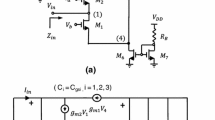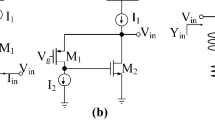Abstract
A fully integrated 600 MHz CMOS active inductor based voltage-controlled oscillator (VCO) is presented. The active floating inductor configuration employs voltage differencing transconductance amplifier as a building block. In the proposed circuit topology, frequency tuning is realized by varying the bias current of the tunable inductor. The designed VCO achieves an output frequency of 450–750 MHz, resulting in the tuning range of 50%. The simulated phase noise lies within −92.37 to −86.16 dBc/Hz at 1 MHz offset and the VCO draws 426.98–1100 µW from a 1 V supply voltage. The proposed RF oscillator is designed and implemented in a 45-nm CMOS process and its performance is estimated using Virtuoso Analog Design Environment of Cadence.



















Similar content being viewed by others
References
Adiseno MN, Ismail M, Olsson H (2002) A wide-band RF front-end for multiband multistandard high-linearity low-IF wireless receivers. IEEE J Solid State Circuits 37(9):1162–1168
Arbel AF, Goldminz L (1992) Output stage for current-mode feedback amplifiers, theory and applications. Analog Integr Circuit Signal Process 2(3):243–255
Babaei Kia H, Khari A’ain A, Grout I (2014) Wide tuning-range CMOS VCO based on a tunable active inductor. Int J Electron 101(1):88–97
Biolek D, Senani R, Biolkova V, Kolka Z (2008) Active elements for analog signal processing: classification, review, and new proposals. Radioengineering 17(4):15–32
Fabre A (1992) Gyrator implementation from commercially available trans impedance operational amplifiers. Electron Lett 28(3):263–264
Fillaud M and Barthelemy H (2008) Design of a wide tuning range VCO using an active inductor. In: 2008 joint 6th international IEEE Northeast workshop on circuits and systems and TAISA conference, Montreal, QC, pp 13–16
Georgescu BA (2003) Spiral inductor Q-enhancement techniques. Ph.D. Dissertation, University of Calgary
Grzegorz S, Baldwin G and Farrell R (2007) Wideband 0.18 μm CMOS VCO using active inductor with negative resistance. In: 2007 18th European conference on circuit theory and design, Seville, p 990–993
Hajimiri A, Lee TH (1998) A general theory of phase noise in electrical oscillators. IEEE J Solid State Circuits 33(2):179–194
Hajimiri A, Lee TH (1999) Design issues in CMOS differential LC oscillators. IEEE J Solid State Circuits 34(5):717–724
Hajimiri A, Lee TH (2000) The design of low noise oscillators. Kluwer, Norwell
Lawanwisut S, Satthaphol P, Payakkakul K, Pipatthitikorn P, Siripruchyanun M (2016) A temperature-insensitive current-mode multiplier/divider using only double-output VDTA. Proced Comput Sci 86:156–159 (Elsevier)
Lee TH (2004) The design of CMOS radio-frequency integrated circuits, 2nd edn. Cambridge University Press, New York
Leeson D (1966) A general theory of phase noise in electrical oscillators. Proc IEEE 54:329–330
Lin TYK, Payne A (2000) Design of a low-voltage, low-power, wide-tuning integrated oscillator. In: ISCAS 2000, IEEE International symposium on circuits and systems, vol 5, 28–31 May 2000, pp 629–632
Nandi R (1980) Lossless inductor simulation: novel configurations using DVCCS. Electron Lett 16(17):666–667
Nguyen NM, Meyer RG (1992) Start-up and frequency stability in high-frequency oscillators. IEEE J Solid State Circuits 27(5):810–820
Pal K, Nigam MJ (2008) Novel active impedances using current conveyors. J Act Passive Electron Devices 3:29–34
Parveen T, Ahmed MT (2006) Simulation of ideal grounded tunable inductor and its application in high quality multifunctional filter. Microelectron J 23(3):9–13
Prasad D, Bhaskar DR, Singh AK (2010) New grounded and floating simulated inductance circuits using current differencing transconductance amplifiers”. Radioengineering 19(1):194–198
Prasad D, Bhaskar DR, Pushkar KL (2011) Realization of new electronically controllable grounded and floating simulated inductance circuits using voltage differencing differential input buffered amplifiers. Act Passive Electron Compon. doi:10.1155/2011/101432
Razavi B (1996) A study of phase noise in CMOS oscillators. IEEE J Solid State Circuits 31(3):331–343
Razavi B (1998) RF microelectronics. Prentice Hall, Upper Saddle River
Satansup J, Tangsrirat W (2014) Compact VDTA-based current-mode electronically tunable universal filters using grounded capacitors. Microelectron J 45(6):613–618
Semiconductor Industry Association (SIA) International Technology Roadmap for Semiconductors (2009) Edition (Online). http://www.itrs2.net/itrs-reports.html. Accessed 20 May 2017
Sotner R, Jerabek J, Herencsar N, Petrzela J, Vrba K, Kincl Z (2014) Linearly tunable quadrature oscillator derived from LC Colpitts structure using voltage differencing transconductance amplifier and adjustable current amplifier. Analog Integr Circuit Signal Process 81(1):121–136
Tsitouras A, Plessas F, Kalivas G (2011) A linear, ultra-wideband, low-power, 2.1–5 GHz, VCO. Int J Circuit Theory Appl 39:823–833. doi:10.1002/cta.670
Yesil A, Kacar F, Kuntman H (2011) New simple CMOS realization of voltage differencing transconductance amplifier and its RF filter application. Radioengineering 20(3):632–637
Yuan F (2008) CMOS active inductors and transformers. Springer, New York
Yuce E (2008) Grounded inductor simulators with improved low frequency performances. IEEE Trans Instrum Meas 57(5):1079–1084
Yuce E, Minaei S, Cicekoglu O (2005) A novel grounded inductor realization using a minimum number of active and passive components. ETRI J 27(4):427–432
Yue P, Wong SS (2000) Physical modeling of spiral inductors on silicon. IEEE Trans Electron Devices 47(3):560–568
Author information
Authors and Affiliations
Corresponding author
Rights and permissions
About this article
Cite this article
Kumar, V., Mehra, R. & Islam, A. A CMOS active inductor based digital and analog dual tuned voltage-controlled oscillator. Microsyst Technol 25, 1571–1583 (2019). https://doi.org/10.1007/s00542-017-3457-y
Received:
Accepted:
Published:
Issue Date:
DOI: https://doi.org/10.1007/s00542-017-3457-y




